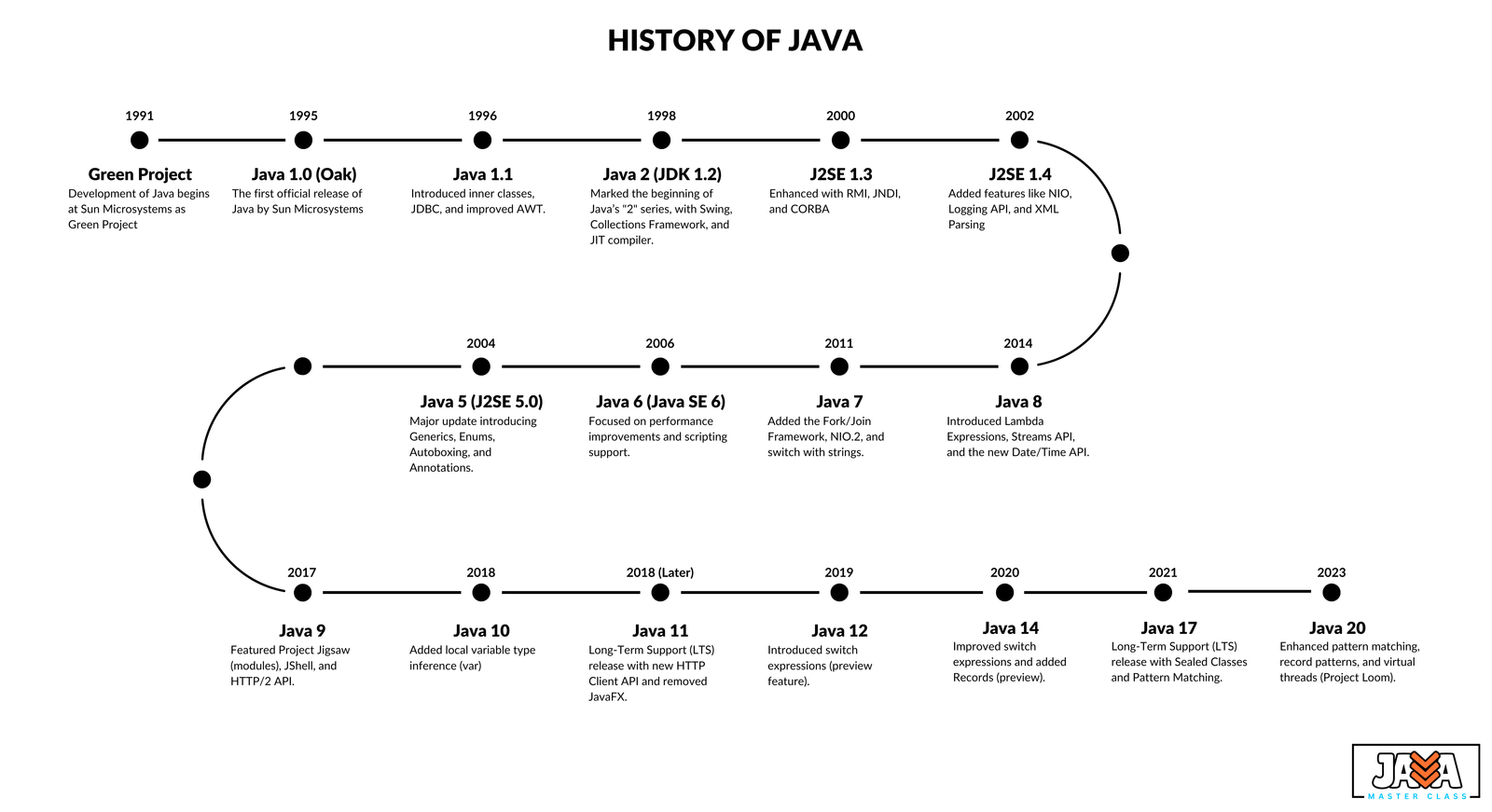Java, one of the most influential and widely used programming languages in the world, has a rich history filled with innovation, evolution, and success. It has played a critical role in shaping the development of modern software applications, from web-based solutions to mobile apps, enterprise systems, and beyond.
The Birth of Java
Java’s journey began in 1991, when James Gosling, Mike Sheridan, and Patrick Naughton, engineers at Sun Microsystems, initiated a project called the “Green Project.” Their goal was to create a language that could be used for consumer electronics, particularly interactive television, but they soon realized that the project could be more broadly applied to the emerging field of networked devices. Initially, Java was called Oak after an oak tree outside Gosling’s office. However, the name was later changed to Java after the developers discovered that “Oak” was already trademarked.
Java was designed with a few key goals in mind:
- To be platform-independent, allowing developers to write code once and run it anywhere.
- To be secure and robust, addressing the increasing concerns around the safety of running applications on the internet.
- To be simple and easy to learn, drawing inspiration from C and C++ but removing their complexities.
The First Release: Java 1.0
In 1995, Java saw its first public release as Java 1.0 on Sun Microsystems’ website. This marked the beginning of Java’s rise to prominence. The new language was built around the idea of “Write Once, Run Anywhere” (WORA), meaning that Java code could run on any platform that had a Java Virtual Machine (JVM). This was a revolutionary idea at the time when other programming languages required specific machine-level instructions.
Java 1.0 was a success, but it was clear that more functionality would be needed. Sun Microsystems started to develop various libraries and tools that could leverage Java’s platform independence. These included the core libraries and APIs, such as the Abstract Window Toolkit (AWT) for graphical user interfaces (GUIs), and the networking classes for internet communication.
The Explosion of Java in the Late 1990s
As the 1990s progressed, Java gained more traction, especially due to the rapid growth of the internet. The world was becoming more connected, and Java’s ability to work across different platforms made it a perfect fit for web-based applications. In 1996, Sun Microsystems launched the Java 2 Platform, which introduced new features such as:
- Swing: A new set of GUI components that allowed for more sophisticated interfaces.
- Java 2 Standard Edition (J2SE): The platform for desktop applications and general-purpose applications.
- Java 2 Enterprise Edition (J2EE): A set of APIs designed for building large-scale, distributed enterprise applications, including technologies like Servlets and JSP (Java Server Pages).
- Java 2 Micro Edition (J2ME): A version of Java designed for embedded systems and mobile devices.
In the late 1990s, Java’s usage exploded with the proliferation of web development and the increasing demand for cross-platform solutions. Java applets, small programs that could run in web browsers, played a major role in this growth, although they eventually lost popularity due to security concerns and the rise of other web technologies like Flash and JavaScript.
The Shift Towards Open Source: Java’s Evolution
As Java continued to grow in the 2000s, it evolved to meet the demands of new technologies. One of the key moments during this period was Sun Microsystems’ decision to open-source Java in 2006. This move was a turning point for the language, allowing the community to contribute to its development and ensure that Java would remain relevant in the changing technological landscape.
In 2009, Sun Microsystems was acquired by Oracle Corporation, which would become a key player in Java’s future development. Oracle promised to maintain Java’s open-source status and continued to enhance the platform with significant releases:
- Java 5 (J2SE 5.0): Released in 2004, Java 5 introduced major language features such as generics, metadata annotations, and the enhanced for-loop, which significantly improved the expressiveness and flexibility of Java.
- Java 6: Released in 2006, this version focused on performance improvements, including enhancements to the JVM and the introduction of the scripting API, allowing developers to use scripting languages like JavaScript within Java applications.
- Java 7: Released in 2011, it brought more language features and JVM improvements, such as the try-with-resources statement for better resource management and the introduction of the fork/join framework for parallel computing.
- Java 8: Released in 2014, Java 8 was a landmark release that introduced functional programming features to the language, including:
- Lambda expressions: Allowing developers to write more concise and functional code.
- Streams API: A powerful way to process sequences of elements (e.g., collections) in a functional style.
- Default methods: Methods in interfaces that have a default implementation, making it easier to evolve APIs without breaking existing implementations.
Java’s Role in the Modern Era
Java continues to be one of the most widely used programming languages, thanks to its robust ecosystem and community-driven development. In the 2010s, the Java community also adopted the Java Community Process (JCP) to standardize the evolution of the language, ensuring that Java remains open and collaborative.
Oracle’s stewardship of Java has been marked by the release of newer versions:
- Java 9: Released in 2017, Java 9 introduced the module system, which helped manage large codebases and improve security.
- Java 10 and 11: These versions brought incremental improvements and features, including the local-variable type inference in Java 10 and the release of Java 11 as a Long-Term Support (LTS) version, marking a new cadence of regular releases every six months.
- Java 14–17: These releases introduced numerous enhancements like pattern matching, new garbage collection algorithms, and the much-anticipated records feature (a concise way to model immutable data classes) in Java 16.
- Java 17: Released in 2021, Java 17 became the latest LTS release, which meant it would receive extended support for many years, solidifying its role as a dependable platform for large-scale applications.
Java’s adaptability in the face of new technologies such as cloud computing, microservices, and containerization has helped it remain relevant in modern development practices. The language’s continued focus on performance, scalability, and security makes it a top choice for enterprise solutions, mobile apps (via Android), and big data systems.
Java’s Ecosystem and Community
Java’s developer community is also one of the largest in the world, with numerous resources, forums, conferences, and open-source projects available for those wishing to learn and grow in the Java ecosystem. One of the reasons for Java’s sustained success is its vibrant and active ecosystem which includes:
- The Java Virtual Machine (JVM): The heart of the Java platform that runs Java applications, and over the years, it has supported other languages such as Kotlin, Scala, and Groovy, expanding the reach of the JVM.
- Spring Framework: An influential framework that has become synonymous with enterprise Java development.
- Apache Hadoop and Spark: Frameworks used for big data applications written in Java.
- Android Development: Although Android has shifted to Kotlin as its primary language, Java continues to be widely used in Android app development.
- OpenJDK: An open-source implementation of the Java Platform, Standard Edition, which Oracle sponsors.
References
- Oracle Java History: Oracle Java History
- ‘The Java Programming Language’ (Book): ISBN: 978-0321349803
- Sun Microsystems Archives: Sun Microsystems Archive
- ‘The Java Language Specification’ (Book): ISBN: 978-0134685991
- ‘Java: A Beginner’s Guide’ by Herbert Schildt: ISBN: 978-0071808552
- Java Enhancement Proposals (JEPs): Java Enhancement Proposals
- JDK Release Notes: JDK Release Notes

